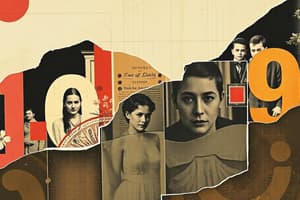Podcast
Questions and Answers
What is the result of 4 ÷ 2?
What is the result of 4 ÷ 2?
- 1
- 3
- 4
- 2 (correct)
In the number 123, what is the value of the digit 2?
In the number 123, what is the value of the digit 2?
- 100
- 20 (correct)
- 1
- 2
What is the result of 3 x 4?
What is the result of 3 x 4?
- 12 (correct)
- 7
- 10
- 15
What is the result of 5 + 3?
What is the result of 5 + 3?
What is the result of 8 - 3?
What is the result of 8 - 3?
What is the result of 6 ÷ 3?
What is the result of 6 ÷ 3?
In the number 456, what is the value of the digit 4?
In the number 456, what is the value of the digit 4?
What is the result of 2 x 6?
What is the result of 2 x 6?
What is the result of 7 + 4?
What is the result of 7 + 4?
What is the result of 9 - 4?
What is the result of 9 - 4?
Flashcards are hidden until you start studying
Study Notes
Arithmetic Base Ten
Arithmetic involves the use of numbers to perform operations such as addition, subtraction, multiplication, and division. Base ten arithmetic is a method of performing these operations using the ten digits from zero to nine, with the possibility of using the digit zero as a placeholder.
Division
In base ten arithmetic, division is the process of splitting a number into equal parts. Division is represented by the division symbol "÷" or by using the word "divided by." For example:
- 4 ÷ 2 = 2
- 3 ÷ 3 = 1
- 5 ÷ 5 = 1
Place Value
The concept of place value is crucial in base ten arithmetic. Each digit in a number has a value based on its position, with the rightmost digit having the lowest value and the leftmost digit having the highest value. For example, in the number 123, the digit 3 represents 30, the digit 2 represents 20, and the digit 1 represents 100.
Multiplication
Multiplication is the process of finding the total number of times a number is repeated. In base ten arithmetic, multiplication is represented by the multiplication symbol "x" or the word "times." For example:
- 3 x 2 = 6
- 4 x 5 = 20
- 6 x 7 = 42
Addition
Addition is the process of combining two or more numbers to find the total. In base ten arithmetic, addition is represented by the "+" symbol or the word "plus." For example:
- 3 + 2 = 5
- 4 + 5 = 9
- 6 + 7 = 13
Subtraction
Subtraction is the process of finding the difference between two numbers. In base ten arithmetic, subtraction is represented by the "-" symbol or the word "minus." For example:
- 3 - 2 = 1
- 4 - 5 = -1
- 6 - 7 = -1
The subtraction of larger numbers may involve borrowing or carrying over from previous columns. This process is also known as regrouping or carrying the one. For example:
- 42 - 23 = 19
- 35 - 24 = 11
- 51 - 34 = 17
Studying That Suits You
Use AI to generate personalized quizzes and flashcards to suit your learning preferences.




